
Contents










Local Taste · Written by Korean Food Promotion Institute Photographed by Studio Kenn
Pork Dish Supreme
Dombegogi
Dombe in Jeju dialect means “cutting board,” and dombegogi is an indigenous dish of Jeju-do Island
that is cooked with boiled meat placed as-is on a board and cut. Black pigs, which have adapted to
the island’s unique weather and climate over a long period of time, have provided a dish natives have
enjoyed during family and village events. The thickly cut meat and white bare skin of dombegogi,
which is cut on a large cutting board because serving individual dishes is difficult,
comprise a culinary masterpiece from Jeju-do Island.
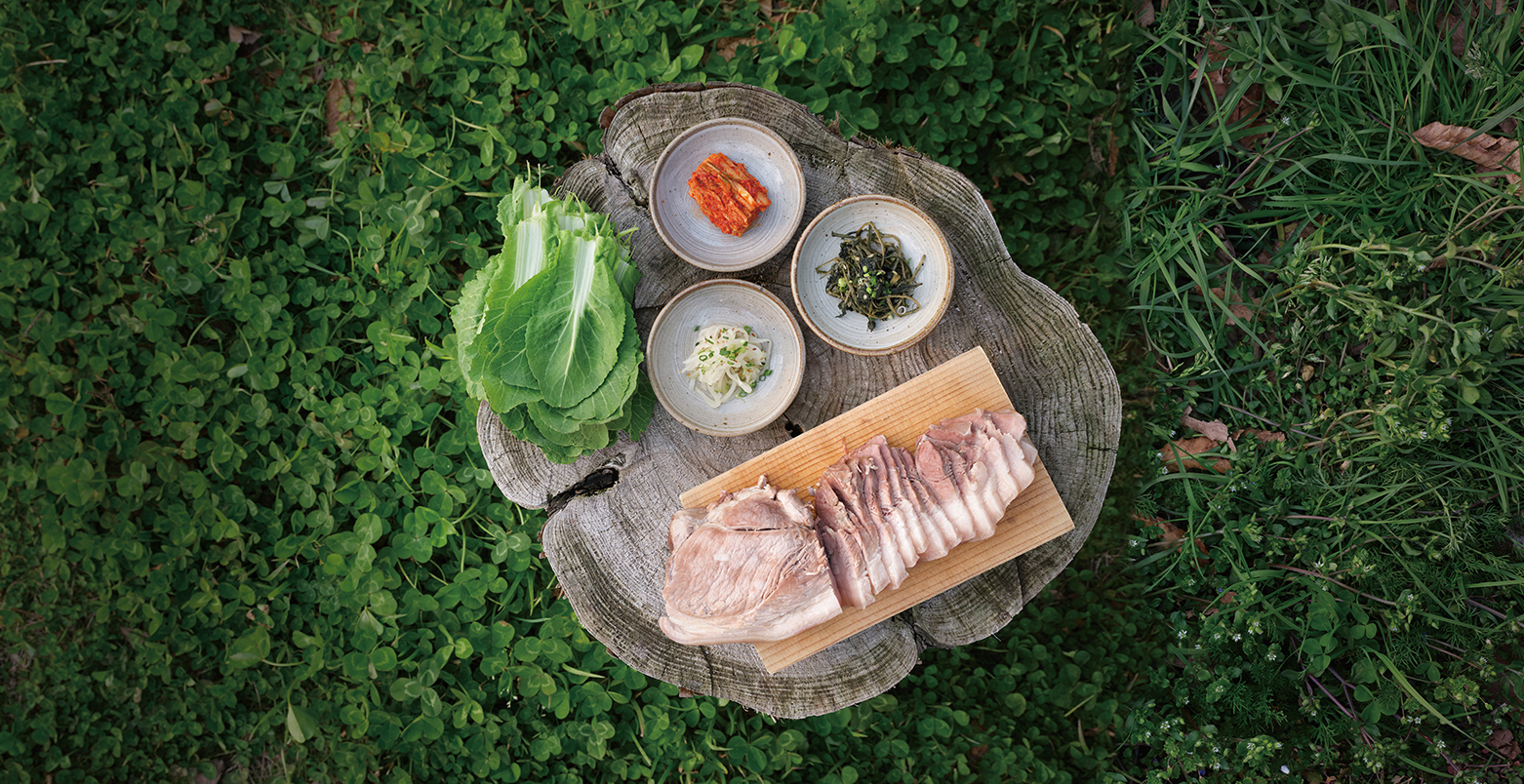
The pork from black pigs on Jeju-do Island is soft and not so oily, making it a popular dish that most tourists try at least once. Able to weather rain and heat, the pigs are acclimated to the island’s unique climate. Until about four decades ago, natives raised the black pigs at dottong, a type of outhouse, and perhaps this is how the hogs gained the nickname ddong dwaeji (poop pig). Over time, the custom of breeding the pigs at outhouses slowly disappeared, and many farmers started to crossbreed pigs to produce more meat. This consequently jeopardized the fate of the island’s black pigs. The Jeju Livestock Promotion Institute stepped in to save the remaining pure indigenous black pigs and breed them. This native species is protected today after being designated a natural heritage in 2015, but this means that the pork served on the island are not from the indigenous black pigs but crossbreeds. Of course, Jeju pork, even if not from such pigs, is still considered the best in Korea.
Though dombegogi is one of the island’s more famous pork specialties, it was something residents seldom ate in the past since it was reserved for village banquets or rituals. Once a pig was caught, it was placed in a pot to immediately boil. To remove the pig’s odor, soybean paste and garlic were added to the pot. Nowadays, a variety of spices cater to the diverse taste preferences. Unlike their counterparts on the mainland, who flattened boiled meat and cut it in slices to make pyeonyuk, Jeju residents cut the meat on a doma (or dombe as they call it), or cutting board, before letting it cool and serving it right away. This is how dombegogi got its name.
Generally, dombegogi looks similar to suyuk (boiled meat slices) that people eat on the mainland. Making suyuk requires boiling a chunk of meat, usually beef or pork, and then pressing and cutting it into thin slices. Beef suyuk is served slightly dipped in a inegarmixed soy sauce or mustard-mixed red chili pepper paste, while pork suyuk is wrapped with pieces of cabbage kimchi and a touch of salted shrimp sauce. Pork suyuk commonly uses the belly, head or feet of the pig but on the island, a chunk of pork is boiled in a large pot without the meat being divided in a specific way. To eat pork suyuk just like on Jeju is a real treat. Though both are boiled pork, dombegogi has a taste far different from suyuk on the mainland. Even while eating suyuk from time to time on the mainland, many former residents of the island say they have never forgotten dombegogi.
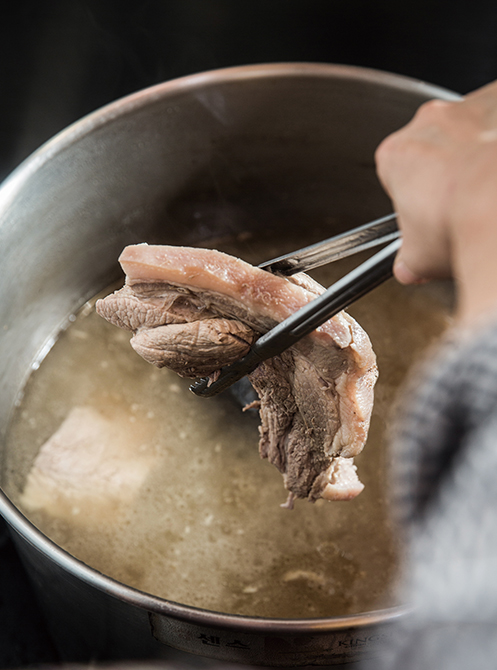 To remove the pig’s odor, soybean paste and garlic are added to the pot. © Korean Food Promotion Institute
To remove the pig’s odor, soybean paste and garlic are added to the pot. © Korean Food Promotion Institute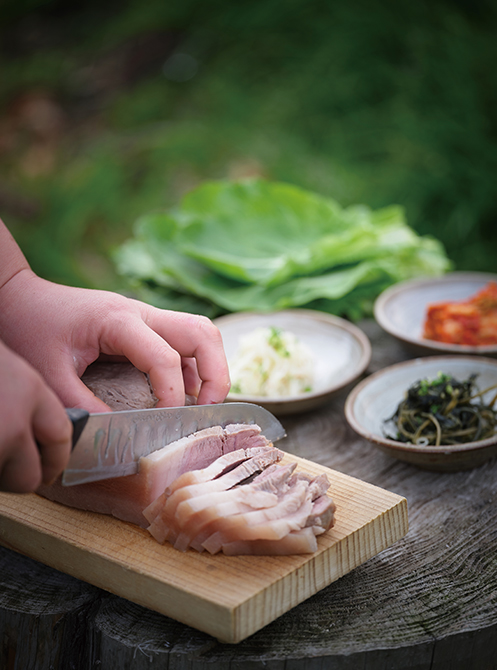 Boiled and softened, the meat is easily sliced.
Boiled and softened, the meat is easily sliced.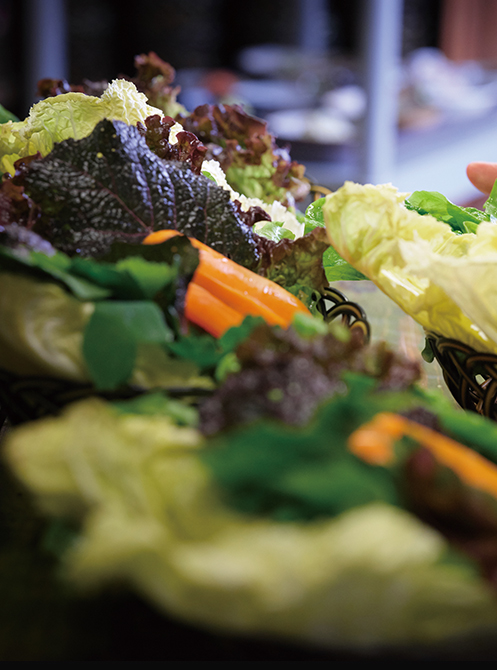 Fresh vegetables from the garden are served with the dish.
Fresh vegetables from the garden are served with the dish.Taste of Pure Nature
Anywhere on Jeju-do Island has many restaurants serving generous portions of ssambap jeongsik, or a set menu of vegetable wraps and rice with dombegogi as the main dish. Pork, along with garlic, onions, shiitake mushrooms and garlic cloves, is boiled in a pot for about 40 minutes. Then the boiled meat is kept in the pot with the lid closed and simmered for over 30 minutes to tenderize the meat. When someone orders the dish, the pork is immediately removed from the pot and cut into proper sizes before being placed on a small dombe and served in front of the customer. Dombegogi should be eaten just after it comes out of the pot as it will be nice and hot and possess the right balance of oiliness and flavor, a taste Jeju residents describe as baejigeun. Freshly boiled pork from a black pig emerges from a pot that emits a dense smoke. A thick chunk is placed on a dombe and served. Before the hot energy disappears, cut a rather crude slice, dip it gently in coarse salt and place it in your mouth. By chewing the moist and soft meat, the delicious flavors hidden inside the pork slowly ooze out. The warm dombegogi is served neatly on a table along with other side dishes ranging from fresh vegetables and sizeable grilled mackerel to seasoned aster from the town of Aewol-eup and a cold soup that contains the brown sea vegetable hijiki collected from the island’s clean sea. All the vegetables have been cultivated at farms on the island.
Island residents have an optimal way to savor the taste of the meat: dipping dombegogi in coarse salt or vinegar-mixed soy sauce. Diners also use salted anchovy, which admirably eliminates any remaining grease in the pork. Thus eating dombegogi with fresh vegetables cultivated in Jeju fields is an incredibly delicious experience. The soft fat whose greasiness is just enough, gooey lean meat, crispy vegetables and piquant garlic all form a gastronomic harmony that is simply irresistible.
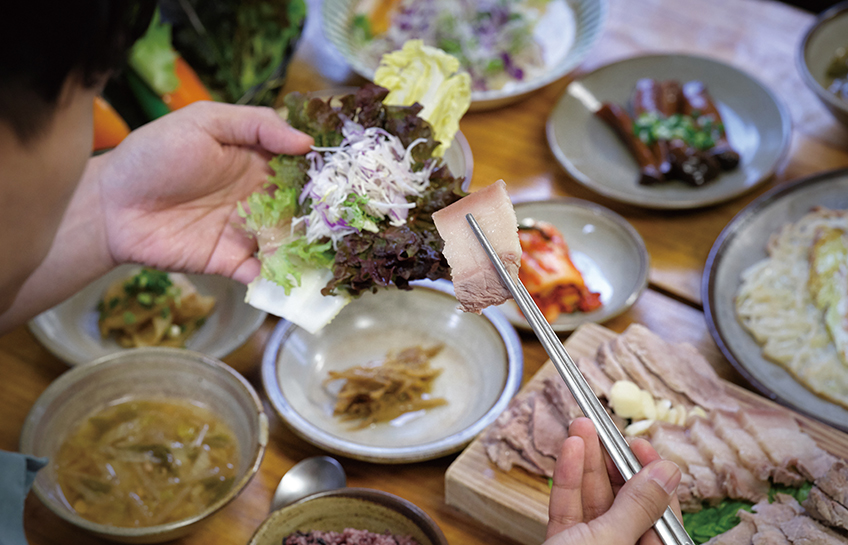
Taste Jeju-do Island’s nature with dombegogi vegetable wraps.
Other Articles






Hanbok Designer Extraordinaire



Bridging Korean and Vietnamese Culture






